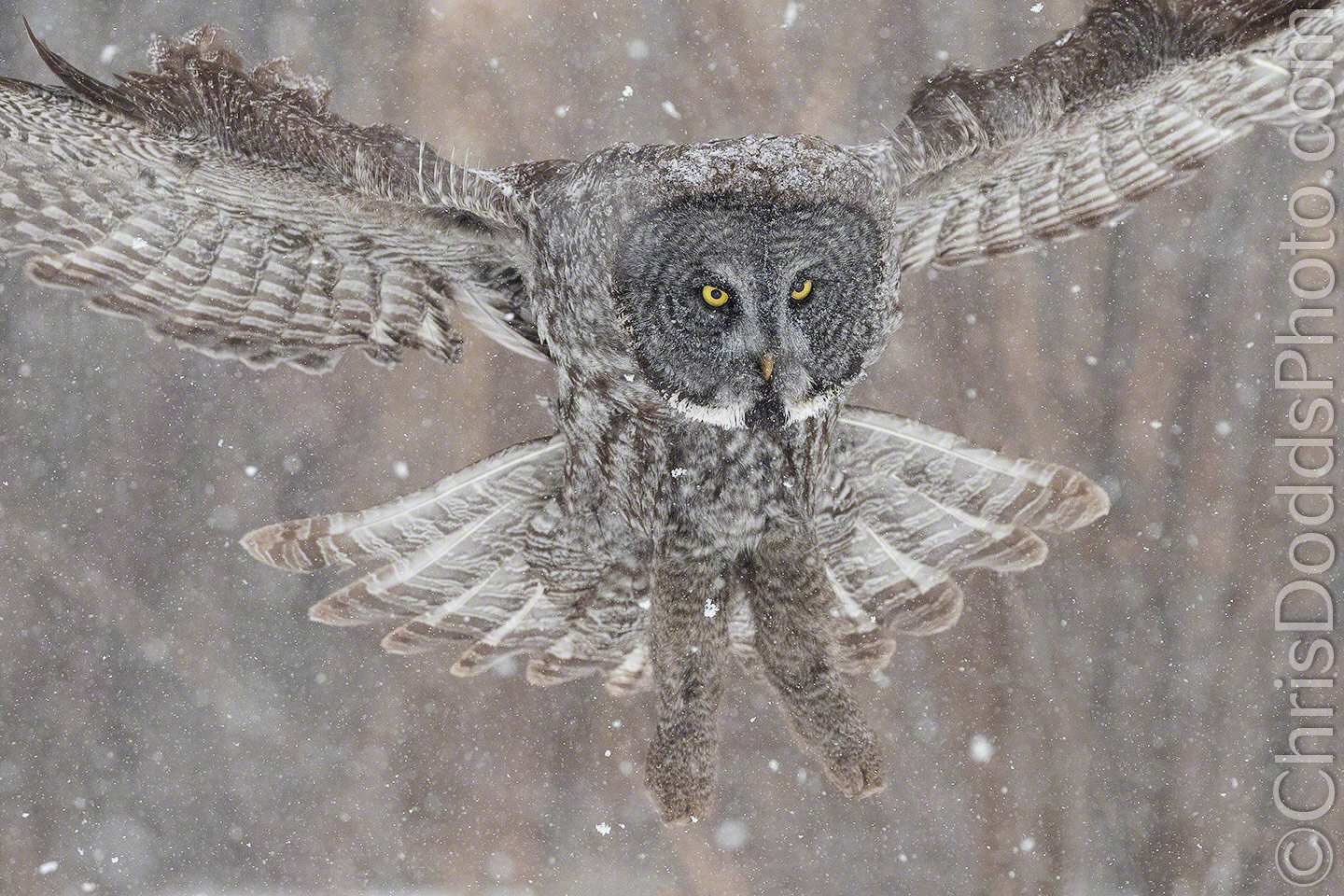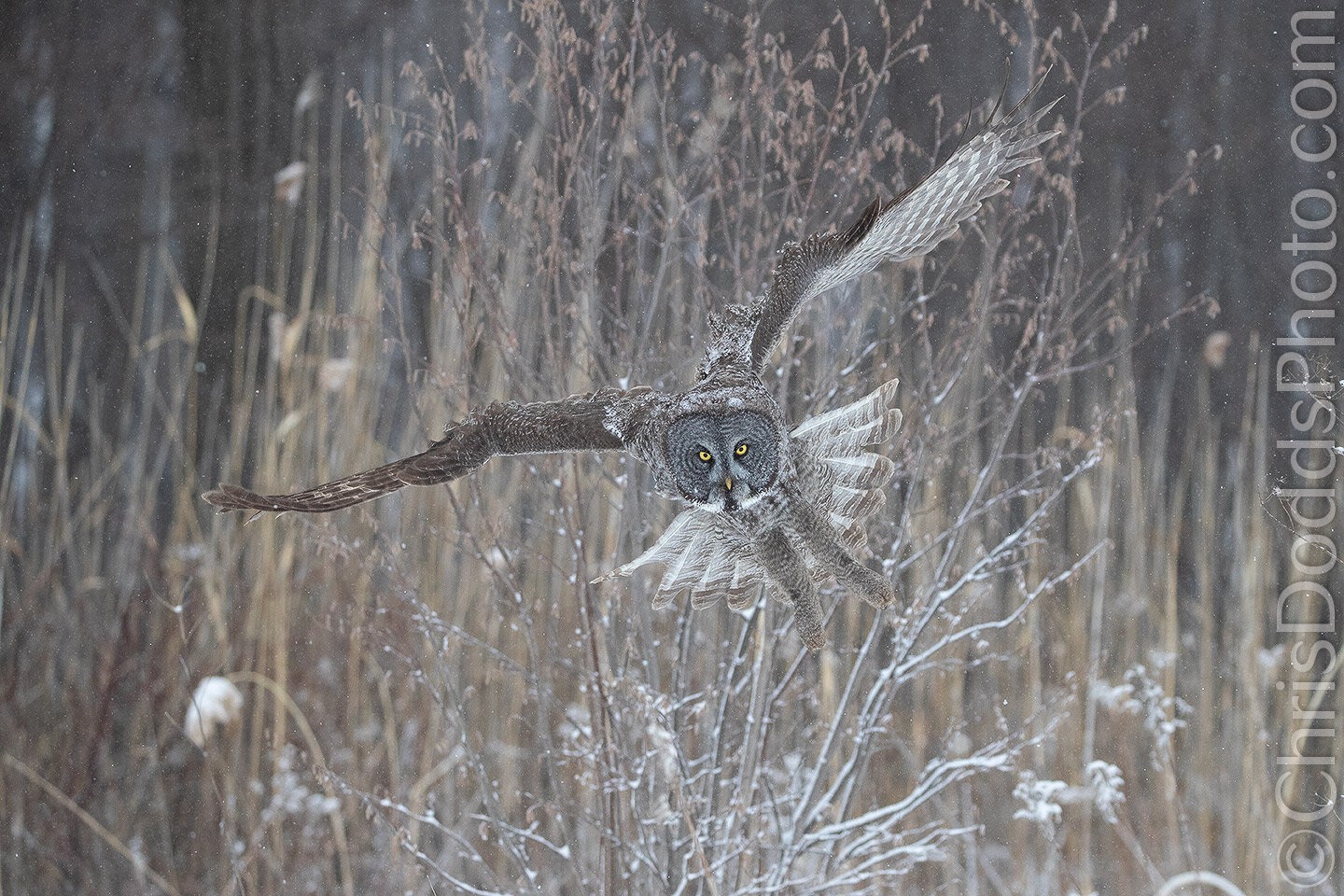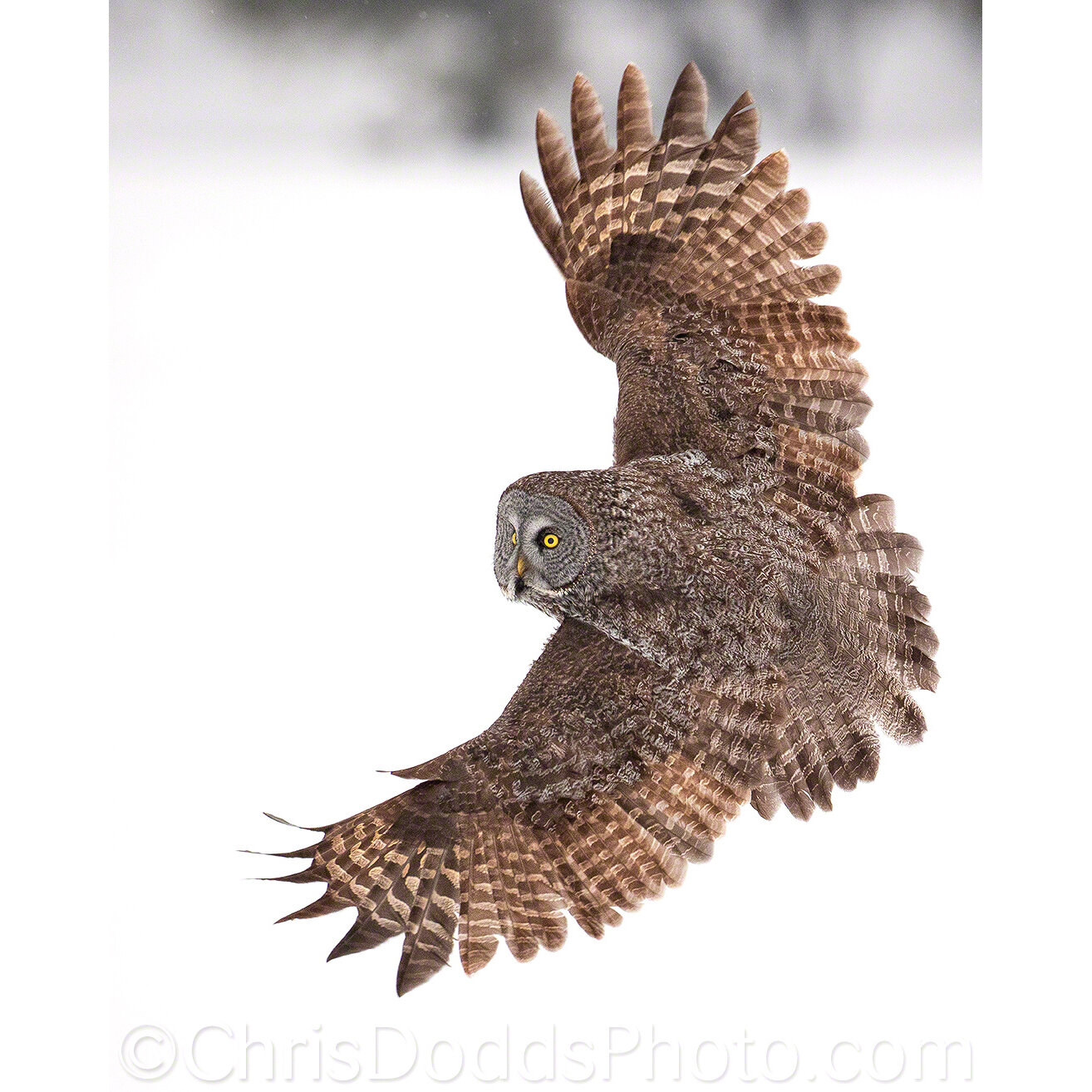Great Gray Owl (Strix nebulosa, Chouette Lapone, GGOW) ©Christopher Dodds from my Winter Snowy Owls Workshop in Ontario from January 2005. Join me for my winter owl workshops this January/February. To learn more, CLICK HERE.
Gret Gray Owl on a Birch Perch
The first whispers of Great Gray Owl arrivals have started to circulate a little later than usual this year. Here is one from my winter owl workshops in 2014 that I love because of its simplicity.
Another Snowy Owl was just seen along the beach near where I host my Deluxe Atlantic Puffin Workshops.
Great Gray Owl on a birch perch (Strix nebulosa, Chouette Lapone, GGOW, Dark Wood Owl, Lapland Owl, Striped Owl, Lapp Striped Owl) ©Christopher Dodds From my Winter Owl Workshops in February, 2014 500mm X 1.4 @700mm ISO 3,200, F5.6 @ 1/2,500s Manual Exposure mode. Join me for my winter owl workshops in January and February
Great Gray Owl Snow Queen
This is a great gray owl image from my winter owl workshop a few years ago. It was snowing so heavily that finding the owl perched quite far from the road was difficult.
Great Gray Owl Snow Queen (Strix nebulosa, Chouette Lapone, GGOW, Dark Wood Owl, Lapland Owl, Striped Owl, Lapp Striped Owl) ©Christopher Dodds Sony Alpha a1 Mirrorless Camera & Sony FE 200-600mm f/5.6-6.3 G OSS Lens @201mm ISO 2,500, F6.3 @ 1/3,20s Manual Exposure mode. Full frame image. Join me for my winter owl workshops in January & February.
“I just returned home from a trip to Ontario, Canada with Christopher Dodds to look for and photograph Snowy Owls. The weather was cold and snowy, but not necessarily Snowy Owl cold, so I was worried that the Snowy Owls might be thin on the ground. Christopher Dodds deserves kudos and my thanks! He led our photo trek and put me (and the others in the party I joined) in position to see, watch, track and photograph Snowy Owls. I was able to capture wonderful images of Snowy Owls at rest, in flight, on the hunt, on the ground in the fields, in blowing snow! Outstanding photographic results for me, better than I anticipated. From the get go it was obvious that Christopher Dodds knows his Snowy Owls and wildlife photography. He is an excellent photography trek leader, knowledgeable, personable, professional and helpful to me and the others in our group at every turn. I am impressed with Christopher as a photography trek leader, particularly as his focus was on his clients at all times, and the well being of the Owls. He ensured that we did everything possible to not stress or disturb the Owls in their habitat. Of particular note Christopher is not a photography trek leader who spends his time with his own camera, taking his own photographs. He spent all his time with us locating Owls, coaching us, helping us with our equipment and camera settings, and letting us know what to expect and when to expect an Owl to fly, in what direction, and when. What an outstanding experience! Thank you, Christopher. I hope to enjoy another trek with you soon.”
Great Gray Owl
A favourite Great Gray Owl image from one of my Winter Owl Workshops in 2013 that I just reprocessed before making a 40” X 50” print for a client in The Netherlands.
There are still two spots left for my January 27-31 Winter Owl Workshop.
Great Gray Owl (Strix nebulosa, Chouette Lapone, GGOW, Dark Wood Owl, Lapland Owl, Striped Owl, Lapp Striped Owl, Great Grey Owl) ©Christopher Dodds from my winter owl workshops in 2023 @344mm ISO 5,000, F5,6 @ 1/5,000s Manual Exposure mode. Join me for my winter owl workshops in January.
Great Gray Owl Phantom of the North
I photographed this Great Gray Owl (Great Grey Owl in some parts of the world) using my Sony a1 mirrorless camera with the FE 200-600mm f/5.6-6.3 G OSS zoom lens @348mm in a winter snowstorm during my winter owl workshop.
Owls have such a mysterious grace about them. One of my favourite facts about the Great Gray Owl is that it is an optical illusion. It is one of the largest owls in the world (by length), and, at the same time, it's not that big at all. Great Gray Owls have relatively small bodies but are covered in so many dense layers of long feathers that they appear to be much bulkier than they are.
Great Gray Owl Phantom of the North (Strix nebulosa, Chouette Lapone, GGOW, Dark Wood Owl, Lapland Owl, Striped Owl, Lapp Striped Owl) ©Christopher Dodds Sony Alpha a1 Mirrorless Camera & Sony FE 200-600mm f/5.6-6.3 G OSS Lens @348mm ISO 6,400, F6.3 @ 1/5,000s Manual Exposure mode. Join me for my winter owl workshops in January.
Great Grey Owls LOVERS
Happy Valentine's Day
This image was made in Ontario, Canada, on January 26, 2005. I have a series of about 80 images that I kept from this incredible moment in a field behind a water treatment plant in Bracebridge, Ontario, Canada. Witnessing the affection, vocalizations, and gestures these two Great Grey Owls performed was incredibly touching and unforgettable!
Great Grey Owls LOVERS (Strix nebulosa, Chouette Lapone, GGOW) Ontario, Canada January 26, 2005. © Christopher Dodds All Rights Reserved. Canon 1D Mark II with Canon 100-400 zoom lens @120mm. ISO 250 f/6.3 @ 1/1,600s.
Great Gray Owl STORM (Strix nebulosa, Chouette Lapone, GGOW) Southwestern Quebec, Canada. ©Christopher Dodds All Rights Reserved. Sony Alpha a1 Mirrorless camera & Sony FE 200-600mm f/5.6-6.3 G OSS Lens @255mm ISO 100 @ 1/40s f/510. Full frame image.
Bird Photography Intentional Blur and Q&A
Q:
Christopher,
I am constantly gobsmacked by your exceptional images. The details are captivating to me. I do wonder if you ever slow down your shutter and create artistic blurs? - Peter Wentworth
Hi Peter,
Thank you. Yes, I am not typically a fan of intentional blurs, but I do occasionally play around and slow my shutter speed down. Here is a Great Gray Owl I recently photographed at 1/40s with the new Sony a1 and 200-600mm lens. I find the key to my liking an intentional or artistic blur is having the eye(s) relatively sharp.
Q:
Hello Christopher, I liked your comments on the new alpha 1. How did you find it with the 200-600 zoom. I use this lens with the a7r3. The combo I found a bit slow to focus with wildlife. Where you happy with it on the a1. I have preordered the a1 and hoping to not have to upgrade the lens. Best, - Steve Aidelbaum
Hi Steve,
I think you will notice a significant autofocus performance boost with the focus acquisition speed and AF responsiveness of the 200-600 with the a1 vs. the a7RIII.
Q:
Thank you for responding to my query (Antman) in the comments. I would value your opinion on the following.
If you could buy either the 600MM f4 or A1 what would you go for based on the pairing
A9 + 600mmF4 or A1 + 200-600MM.
I own the A9 + a7R4 and 200-600mm and am wondering what makes more sense. My gut feel says go for the 600mm f4. However, I have never used either and I cannot get to see or feel the 600mm f4 in Australia. Both options have advantages. - Thanks, Anthony Heuver
Hi Anthony,
The most practical and financially sensible direction here is to invest in glass and buy the 600mm f/4 GM lens that you will have for the rest of your life. Camera bodies are refreshed at a staggering pace and the used value of them seems to be diminishing at a faster and faster pace with each new release. You can get a great deal on a new a9 (the version I), or take advantage of the "depressed" market and get a lightly used one: remember the shutter count is much less relevant for a mirrorless camera body and if you use the electronic shutter to achieve the fastest capture rate of 20 fps, there are no moving parts. The a9II has better ergonomics and connectivity, but I see little reason to spend the extra cash at this time. Holding off on the newly released a1 until we see promotional discounts or used bodies on the market will give you time to save money toward the purchase and save on the initial investment.
Great Gray Owl (Strix nebulosa, Chouette Lapone, GGOW) Southwestern Quebec, Canada. ©Christopher Dodds All Rights Reserved. Sony Alpha a1 Mirrorless camera & Sony FE 200-600mm f/5.6-6.3 G OSS Lens @241mm ISO 5,000 @ 1/5,000s f/5.6. Full frame image.
Sony 200-600 with Sony A1 Image Quality
There has been a lot of chatter about the image quality of the Sony 200-600mm zoom lens when used with the new high-resolution Sony a1 camera body. My observations were limited in time and opportunity, but I don't see any issues with the incredible level of detail in this full-frame image of a Great Gray Owl in a snowstorm. I purposely tested the camera in the field as I typically use my equipment to produce the kind of images that excite me.
What I can tell you is that this may not be the best example to clearly define any issues that the lens may have when paired with an ultra-high-resolution camera. If I were to try to find a weakness, then I would test it for edge-to-edge sharpness, chromatic aberration, image degradation, and barrel distortion on something as simple as a black and white chessboard; an image with lots of contrast and linear lines. To test that most accurately and rule out any interference from traffic or ground tremor vibrations I would have to use one of only a very few seismically stable platforms that are typically used to test/measure helicopter or jet engine vibrations.
My advice is to completely ignore the critics who are photographing outside of their usual genre and posting bird pictures that most of us would throw in the trash: always to test equipment under the conditions that you would normally use it - smile.
Great Gray Owl (Strix nebulosa, Chouette Lapone, GGOW) Southwestern Quebec, Canada. ©Christopher Dodds All Rights Reserved. Sony Alpha a1 Mirrorless camera & Sony FE 200-600mm f/5.6-6.3 G OSS Lens @200mm ISO 2,000 @ 1/5,000s f/5.6. Full frame image.
Sony a1 Bird Eye AF The Real Test
To truly test the bird eye AF of the newly launched Sony a1, I needed to find a moving bird against a distracting background that would normally confuse the camera's AF system into focusing on the background. Sounds easier than it was, as I first had to overcome my natural reflex of finding birds and animals against nice clean out-of-focus backgrounds. This image is perfect to demonstrate the ridiculous accuracy of the bird eye autofocus of the Sony a1: Not only is the background close and cluttered (photographing the subject further from the background would have made the background more out of focus and made the whole test easier for the camera), but the subject is relatively low contrast against it. The random scattering of snow covered branches is harder for most autofocus systems to negate when compared to the predictable vertical tree trunks on the edge of a deciduous forest. It was remarkable to see the camera lock onto the eye and follow it through a sequence of 40 images that were all razor-sharp.
Great Gray Owl Dorsal View (Strix nebulosa, Chouette Lapone, GGOW) Southwestern Quebec, Canada. ©Christopher Dodds All Rights Reserved. Sony Alpha a1 Mirrorless camera with Sony 600mm f/4 GM OSS Lens f/5.6 ISO 3,200 @ 1/5,000s. Cropped from Horizontal - full frame on the height.
Sony a1 Bird Eye Autofocus ROCKS
I have been lucky to have had several shoots with this beautiful Great Gray Owl relatively close to home in Southwestern Quebec. It was the perfect model for my recent test of the Sony Alpha A1 for Sony of Canada. It is amazing to think back on all of the owls I have photographed over the years and I can’t remember the last time I got to photograph one completely alone without a group of eager winter owl workshop participants, so this is one silver lining of the Covid-19 pandemic that has wreaked havoc across the travel/workshop industry.
In truth, this is a big and relatively slow moving owl. I would have loved to test the camera and it’s built-in and industry leading bird eye auto-focus on some small and fast moving Auklets in The Pribilofs or Atlantic Puffins in Quebec.
The a1 locked onto the owls eye instantly and stayed locked-on to the eye until the owl’s head turned away from the camera; that is when a larger focus target locked-onto it’s head, and quickly regained it’s lock on the eye as soon as it looked back towards me. The bird eye autofocus in extremely impressive and when combined with the camera’s ability to verify focus 120 per second (twice as often than the a9 & a9II) it truly is a game changer! Does it work every time? Almost; the only time it had a little trouble so far was when pointed at a dark bird in low contract light when it tried hard, but ended-up choosing the bird’s shoulder instead of it’s dark eye.
Great Gray Owl in Jack Pine Tree PEEK-A-BOO (Strix nebulosa, Chouette Lapone, GGOW) ©Christopher Dodds Sony Alpha a9II Mirrorless Camera & Sony FE 200-600mm f/5.6-6.3 G OSS Lens @300mm ISO 1,600, F6.3 @ 1/200s Manual Exposure mode. Join me for my winter owl workshops this January/February to learn more CLICK HERE.
Great Gray Owl PEEK-A-BOO
I love being in the woods looking for owls and I love feeling that something is watching me even more, as was the case here - smile.
The most remarkable moment with this Great Gray Owl was a group of about 14 birders who walked past me and the owl without even replying to my “hello”. No reply, eyes down as if they had already decided that they were not going to see an owl; so they didn’t get to see the owl :)
Great Gray Owl November Sleet (Strix nebulosa, Chouette Lapone, GGOW) ©Christopher Dodds Sony Alpha a9II Mirrorless Camera & Sony FE 200-600mm f/5.6-6.3 G OSS Lens @210mm ISO 3,200, F5.6 @ 1/5,000s Manual Exposure mode. Join me for my winter owl workshops this January/February to learn more CLICK HERE.
Great Gray Owl in November Sleet
Another recent Great Gray Owl image made with the incredibly versatile Sony FE 200-600mm f/5.6-6.3 G OSS Lens as I zoomed out to 210mm. The Sony a9II eye autofocus locked onto the eyes immediately and tracked the owl with ease.
Great Grey Owl Gray November (Strix nebulosa, Chouette Lapone, GGOW) ©Christopher Dodds Sony Alpha a9II Mirrorless Camera & Sony FE 200-600mm f/5.6-6.3 G OSS Lens @285mm ISO 3,200, F5.6 @ 1/5,000s Manual Exposure mode. Join me for my winter owl workshops this January/February to learn more CLICK HERE.
Rechargable hand warmer battery pack review
I accidentally found an incredible solution to my cold fingers from Raynaud’s Disease. The OCOOPA Fast-Charging 10,000mAh back-up battery and handwarmer with PD & QC 3.0 has three temperature settings and heats both sides of its excellent Ergonomic Design: The upper-wide, lower-narrow design is more suitable for grasping than the oval shape fits the natural curve of your palm and is anti-slip. The high-grade silicone oil surface coating is soft and delicate to the touch, and has superior thermal conductivity.
The OCOOPA handwarmer is built to last, with the hottest setting providing a powerful heat that lasts for nearly four hours on high, and more than 12 hours on the lowest setting. This durability ensures that you can rely on the OCOOPA handwarmer for long-lasting warmth, even in the most extreme conditions.
Recharging is super fast; I used an 18W USB wall charger, and charging a completely drained unit took three hours and 12 minutes.
The OCOOPA hand warmer is not just a solution for cold fingers. It's also an excellent power source and backup battery for your mirrorless camera and mobile phone. This versatility empowers you to stay connected and capture your outdoor adventures, all while keeping your hands warm and comfortable.
I now have four of these with me at all times while in the field: one for each loose-fitting mitten and two extra fully charged units as backups in case I accidentally forget to turn off or charge them. On the coldest days, I can use the two extras as heaters in the inside pockets of my parka.

















